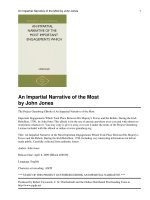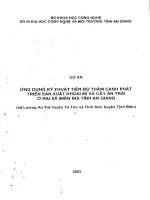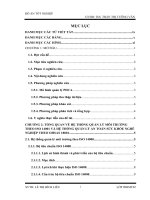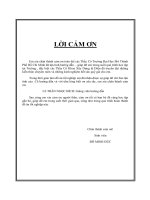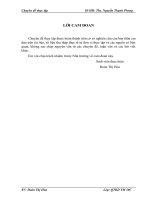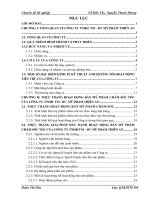My professional journey: An autobiographical narrative
Bạn đang xem bản rút gọn của tài liệu. Xem và tải ngay bản đầy đủ của tài liệu tại đây (378.8 KB, 11 trang )
<span class='text_page_counter'>(1)</span><div class='page_container' data-page=1>
<b>MY PROFESSIONAL JOURNEY: </b>
<b>AN AUTOBIOGRAPHICAL NARRATIVE</b>
Le Van Canh
*<i>Faculty of English, VNU University of Languages and International Studies, </i>
<i>Pham Van Dong, Cau Giay, Hanoi, Vietnam</i>
Received 27 July 2018
Revised 25 September 2018; Accepted 26 September 2018
<b>Abstract: This paper underscores the dynamic and complex dimensions of my being and becoming </b>
an applied linguist. It employs autobiography as an approach to my engagement in self-reflexivity on the
professional re-construction of myself. The purpose behind this self-reflective account is to encourage
an access to localized ways of knowing, being, and becoming in the world. That access is much needed
in language education research in the era in which epistemological understandings are in flux. The paper
concludes by discussing how I re-construe my own professional experiences.
<i>Keywords: autobiographical narrative, professional journey, professional growth, learning English, </i>
teaching English, applied linguistics
<b>1. Introduction1</b>
I am invited to write an article for the
<i>Special Issue of the VNU Journal of Foreign </i>
<i>Studies run by the VNU University of </i>
Languages and International Studies (ULIS)
to mark the 60th<sub> anniversary of the university’s </sub>
English Department. I think it could be best to
tell the story of my learning and professional
trajectory, which is full of twists and turns, for
the purpose of exploring, connecting, sharing
and learning. As Barkhuizen, Benson, and
Chik (2014, p. 37) have asserted, “Language
learning histories (LLHs) are retrospective
accounts of past learning. They are the written
stories of language learning experiences.”
1
* Tel: 84-913563126
Email: /
</div>
<span class='text_page_counter'>(2)</span><div class='page_container' data-page=2>
the discussion of how I re-construe my own
professional experiences.
<b>2. Contextualization </b>
In the field of English language
education, there are diverse realities
that describe English-language teachers.
Each reality comes from a collection of
experiences and paths that determine the
practice of individual teachers. One of
these realities is the one portrayed in the
teacher’s autobiographical narrative, which
is understood as a subjective interpretation
of one own’s life. In other words, although
teachers share their occupation, they are
far from sharing life stories. Every teacher
may be considered a unique world, with a
particular voice portraying their own life
stories and experiences. As a result, the use
of autobiography as a research method has
become increasingly recognized in social
sciences and applied linguistics research over
the past couple of decades (Barkhuizen, et al.,
2014; Pavlenko, 2007; Coffey, 2014). Coffey
(2014, p. 1) describes autobiography as “the
telling and documenting of one’s own life”.
According to Pavlenko (2007, p. 164-165),
“autobiographic narratives offer three major
contributions to research on SLA [Second
Language Acquisition] and bilingualism.
First of all, they offer insights into people’s
private worlds, inaccessible to experimental
methodologies, and thus provide the
insider’s view of the processes of language
learning, attrition, and use. Secondly, they
highlight new connections between various
learning processes and phenomena, and, in
doing so, point to new directions for future
research. Thirdly, autobiographic narratives
constitute a valuable information source
for historic and diachronic sociolinguistic
research in contexts where other sources
are scarce (Nekvapil, 2003).” In a similar
vein, Barkhuizen, et al. (2014) note,
“self-narratives, or the stories people tell about
themselves, help us to understand the ways
in which individuals situate themselves and
their activities in the world.” (p. 2). In the field
of teacher education research, the interest
in autobiographical narratives is grounded
in the belief that “in telling their stories of
experience teachers necessarily reflect on
those experiences and thus make meaning
of them; that is, they gain an understanding
of their teaching knowledge and practice”
(Barkhuizen & Wette, 2008, p. 374). Ellis
(1997) argues that “teachers of second
and foreign languages, it might be argued,
do not exist as a collective, but are highly
differentiated in terms of their background
knowledge, their personal goals, who they
teach and the conditions under which they
teach” (p. 246). Therefore, knowing that we
are preparing ourselves to become English
language teachers, we must understand how
our personal histories may impact our jobs.
</div>
<span class='text_page_counter'>(3)</span><div class='page_container' data-page=3>
writing functions not only as a means of
disseminating knowledge and experience, it
is a central activity for generating, recording,
and analyzing data. In writing his narrative he
engages explicitly with the situatedness of his
experiences, acknowledging that “knowledge
is based on one’s location and identities”
(2012, p. 260) and that “narratives represent
<i>knowledge from the bottom up … [which is] </i>
open to further interpretation” (Canagarajah,
1996, p. 327, original emphasis). In sum, an
autographical narrative is a communicative
space where the writer-teacher takes up
personal issues of being, becoming, and
belonging in contextual and relational
analyses of their situated experiences.
The purpose behind this autographical
narrative is to self-reflect on how the role
of my background, my knowledge and the
conditions in which I have been working has
historically and diachronically played in my
professional life. It entails processes through
which I have reflected on and reconstructed
my own professional life and professional
identity. Throughout the process of writing
my own narrative, I was often reminded of
the shifting sands of time and space. Thus,
my own biographical account can be a source
of reference to other
English-language-teaching (ELT) professionals and applied
linguists working from both inside Vietnam
and outside Vietnam for insightful analysis of
how I exercises agency and shape myself as
an ELT teacher, teacher educator and applied
linguist.
Reflecting on my experiences as a
language learner, language teacher, and an
applied linguist through my autographical
narrative I have managed to identify valuable
strengths from my lived experiences, which
have helped me to gain better understandings
of who I am as an applied linguist and of my
professional landscape.
<b>3. Becoming an English language learner</b>
In November 1974, I, at the age of 19, was
admitted into the Hanoi College of Foreign
Language Teachers (now VNU University of
Languages and International Studies) through
the national entrance examination. Neither
the College nor English was my choice. It was
arranged by unknown people. Born and raised
in a poverty-stricken rural area, I thought the
College had a beautiful campus with
high-rise buildings. Having set foot on the campus,
I was shocked seeing a few long
thatch-roofed houses with walls being made of clay
surrounded by green paddy fields. Soon, I
realized that those cottage houses were the
faculty residence and student dormitories. In
addition, there were a couple of brick
two-and four-storey buildings, the former seating
the College’s Administration and the library
while the latter housing the classrooms.
At that time, Russian and Chinese were
two dominant foreign languages taught at
secondary and tertiary levels of education.
English was considered to be the language
spoken in capitalist countries and as a result
it did not have any social status. While I
was arranged to take the teacher training
programme, very few upper secondary schools
taught English. Consequently, I had quite a
vague idea of my future career though this fact
did not bother me much (probably because
of then societal milieu). I also realized that
the College English language lecturers were
equally low in the social and economic ladder
as compared with their Russian or French
language peers.
</div>
<span class='text_page_counter'>(4)</span><div class='page_container' data-page=4>
classmates laughed at me because of my
‘funny’ pronunciation. The English sounds
seemed to be too challenging to me. Honestly
speaking, I was so frustrated with my learning
that I from time to time thought of quitting.
However, all the lecturers from the English
Department were so helpful and enthusiastic.
Besides the classroom hours, they, in the
evening, visited the students frequently at
the thatched dormitory lit by kerosene lamps,
providing tutorials to the students. What
impressed me was that everybody worked so
hard both individually and in groups albeit
without clearly-defined reasons of learning
English. And everybody was making progress
to varying degrees, which was reflected in
their progress test scores. This encouraged
me a great deal and I talked to myself that
if I worked harder, I could learn better. I
practiced the English pronunciation day and
night, reading aloud single sounds or words
repeatedly. My throat became hoarse. I got up
as early as possible every morning, lying in
bed and practicing English sounds. Despite
my great effort, progress was invisible. I felt
so shy and humiliated every time I was called
to read English in the classroom. It was not
until the beginning of the second year of the
training programme when improvement in my
English pronunciation was surfaced. Having
completed the second year of the training
programme, I began to find myself feeling
tremendous affection toward English, and I
had a completely different sense of myself
as a language learner. This motivated me to
work harder and move to the ever higher level
of academic performance as reflected in the
better marks I was given in the forms-focused
progress and achievement tests.
Like all other students of my time, I was
taught English with a Grammar-Translation
Method. During the first two years, the
‘textbook’ were written by Vietnamese
authors, all being the College’s senior
lecturers. Each lesson was composed of
pronunciation drill exercises, a text and
forms-focused exercises. For the last three years of
the training program, the textbooks used were
all written by Soviet linguists with a focus on
classic English literature and forms-focused
exercises. While being called ‘textbooks’,
they were actually stenciled copies of the
original version with pages of each individual
lesson pinned together and distributed to the
students on the weekly basis. More often than
not, students did not have the ‘textbook’ until
the lesson had been taught. There was no such
a thing as skill-based teaching and nobody
had ever known of Communicative Language
Teaching. A dictionary was a dreamed luxury
not only to students but to the majority of
lecturers as well. Actually, the first bilingual
English-Vietnamese dictionary was not
available on bookshop shelves in Northern
Vietnam until 1980.
</div>
<span class='text_page_counter'>(5)</span><div class='page_container' data-page=5>
writing skills in Vietnamese were so helpful
to me in writing English ‘essays’ because I
was one of the best students at Vietnamese
literature at secondary school. This explained
the great difficulty I had in writing the course
assignment following my admission to the
Master’s Degree programme in TESOL in
1996. While my lexical and grammatical
knowledge was not so bad, my ability to
speak and to understand spoken English
was limited. This is because I, like all other
students, had to learn and memorize a large
vocabulary size and abstract grammatical
rules for examinations.
When I became the fourth-year student, I
was, for the first time, taught a subject called
<i>Teaching Methods. The text was entitled “A </i>
<i>Conscious-Practical Approach to Foreign </i>
<i>Language Teaching”, written by G. V. Rogova, </i>
who was on the faculty of Moscow State
University. The author divided her manual of
17 chapters into three parts covering (i) aims,
content and principles of foreign language
teaching; (ii) approaches to the teaching of
various language skills including translation;
and (iii) curriculum and structure of the school
system. The book was underpinned by the
assumed homogeneity in classroom materials
and methods, as might be expected from the
centralized political system.
Unquestionably, both my peers and myself
had trouble learning English as a major due to
inadequate resources or pedagogy. However,
everybody was engaged in learning the target
language. It was our desire to become effective
users of the target language that explained
why we performed well academically despite
limited quality learning opportunities.
<b>4. Becoming an ELT teacher</b>
Although being an EFL teacher was
not what I really wanted, I at last made it
professionally. I became a full-time EFL
teacher at the English Department in October
1979 and worked there until 1998 when I was
assigned to take an administrative position in
the College. The reason for being staffed at
the English Department was my high scores
in the graduation form-centred examinations
rather than my pedagogical competence.
I did not like the teaching position at the
Department at all but I had no choice because
it was almost impossible to be given a job as
an English language teacher in high schools
at that time. Many of my classmates who
were sent to high schools in the remote rural
or mountainous areas were assigned to teach
physical education or to run errant in the
school because nobody was learning English.
The centrally-planned economy did not care
about actual labour needs.
</div>
<span class='text_page_counter'>(6)</span><div class='page_container' data-page=6>
remained to be ‘hit and miss’ and based upon
a lot of instincts. Some were good instincts;
others were not. Honestly, I did not realize
that I felt into the trap of teaching like I had
been taught. I know now that I should not
have taught like this; I should not have been
this kind of teacher, but at that time I did not
have any other experiences and knowledge
to do otherwise. Although I was not sure
whether my students learned anything from
my teaching, I certainly underwent a steep
learning curve over the course of the first
few years of teaching. I learned how to plan
a lesson, how to explain the complicated and
abstract grammar rules in a more accessible
manner to my students. Particularly, I
learned of the importance of good rapport in
motivating the students.
Within the College and nation-wide,
scholarship and intellectual advancement
were almost at a standstill. No seminars and
workshops were available while the library
had few English-language titles donated
by the Soviet Union. Every week, besides
teaching, teachers in the Department had
one group meeting during which the group
leaders and mentors, who returned from
their MA TESOL programme in Australia,
guided everybody to discuss how to teach the
adapted version of the western commercial
<i>textbooks like the Kernel Lesson series (Neill, </i>
<i>1971), or Mainline English series (Watson </i>
& Quinn, 1975), which were brought home
from overseas by group leaders and mentors
themselves, who also did the adaptation. It
was kind of Lesson Study though nobody
knew of this term then. I managed to learn
a lot professionally from this experience.
Through these activities I realized that each
teacher had her or his own styles, which were
totally different from each other. This had a
great impact on my own teaching practice
and professional awareness.
In December 1995, I got a scholarship
to take a three-month course on language
teaching and test-item writing at the then
University of Cambridge Local Examination
Syndicate (now Cambridge ESOL) in the UK.
As the product of the Grammar-Translation
Method, I found myself unable to speak
English intelligibly and to understand spoken
English in Cambridge. I asked one of my
professors for help and she advised me to go
to the University Library to borrow tapes and
a tape-recorder and practise listening and
improving pronunciation simultaneously.
I followed her advice, working intensively
after the class hours. During the weekend, I
visited different interesting places there, taking
advantage of every opportunity I was offered to
practice conversing with the people I happened
to come across with. After a month, I, to my
excitement, made good progress, which
impressed my professors positively. In addition
to pronunciation, listening and speaking, I
managed to read some basic books about
English teaching methodology to complete my
home assignments. The two books that were
so helpful to me were Widdowson’s (1990)
<i>Aspects of Language Teaching and </i>
<i>Larsen-Freeman’s (1986) Techniques and Principles </i>
<i>in Language Teaching. I found the latter more </i>
useful because the book not only introduced
different teaching techniques but the principles
underlying each technique as well. Although
this was a short, intensive course, I benefited
much from the way professors provided us with
hands-on experience in writing and validating
test items as well as interpreting test scores and
the fundamentals of English language teaching.
I left Cambridge (UK) with some professional
expertise and somehow the Cambridge accent.
</div>
<span class='text_page_counter'>(7)</span><div class='page_container' data-page=7>
is located in Vermont of the United States
of America. It was the first time I had had
the opportunity to study the theoretical and
practical aspects of TESOL systematically.
I was particularly interested in the Second
Language Acquisition Theories Course,
especially Vygotsky’s sociocultural theory
and its implications for language teaching.
As I was fully aware that this might be my
once-in-a-lifetime opportunity to develop
my professional competence, I made
full use of the library and the classroom
discussions to expand my professional
vision. The trouble was I did not know the
difference between reading academic texts
and reading fiction, so I had to struggle with
the required readings of the professional
literature. Luckily the courses on Academic
writing helped me to develop my scholarly
writing and reading skills. The beauty of the
Master’s Degree Course at Saint Michael’s
was that we had to complete it within three
summers instead of full-year attendance.
This gave me ample opportunities to
experiment different things I learnt from
the course in my real classrooms. Also, it
was this activity that brought me to Action
Research as a tool for my professional
growth. Through that independent study
process, I realized the limitations of the
western-initiated notions of Communicative
Approach and Communicative Competence
when applied to my Vietnamese context.
Regretably, I was not confident enough to
publish these empirical findings. However,
I managed to publish it latter under the
<i>title “Language Pedagogy and Vietnamese </i>
<i>Contexts”. I gradually came to be aware </i>
of the need to localize teaching, and this
awareness has always accompanied me on
my professional journey both as a teacher,
teacher educator and researcher. After
three summers, I became more confident in
teaching with a Master’s degree in TESOL
under my belt.
<b>5. From an ELT teacher to an applied </b>
<b>linguist</b>
In December 1999, immediately after I
had completed my graduate study and returned
to Vietnam, I was invited to be a plenary
speaker together with Professor Alastair
Pennycook, Professor James W. Tollefson,
and Professor Diana Larsen-Freeman at the
first-ever international conference on ELT in
Vietnam co-organized by the Asian Institute of
Technology (AIT) in Thailand and the Center
for British Teachers (CfBT) in Hanoi. I was
reluctant to accept the invitation because I had
no experience attending a big international
professional conference and I had no idea what
was expected of a plenary speaker. However,
with the organizer’s encouragement, I managed
to use the knowledge I had gained from the
Saint Michael’s graduate course as well as
my understanding of the need to contextualize
western-based theoretical knowledge,
particularly the empirical evidence of the
limitations of the Communicative Approach
to language teaching as mentioned earlier.
My presentation left a good impression on the
conference participants and the organizers. This
initial success ignited a spark on my imagined
horizon. My first attempt at publication came
in the wake of the conference, placing the first
milestone on my academic journey.
</div>
<span class='text_page_counter'>(8)</span><div class='page_container' data-page=8>
access, and carried out investigations into
my own classes with the graduate students.
I developed a better understanding of the
methodological issues, the learners, the
politics of ELT, and the situated challenges
in teaching and learning English in diverse
contexts within Vietnam. From time to
time, during the summer holiday, when I
was involved in in-service teacher training,
I chatted with the teacher participants to find
out about their beliefs about teaching as well
as their working conditions. The information
I gained helped me to uncover one important
fact that formal training was of little help to
teachers’ instructional practice, which was
largely driven by their mental lives.
I then decided to do my doctoral study
with the University of Waikato in New
Zealand at the age of 53. Having examined
my research proposal, the academic
committee allowed me to choose either full
or partial campus residency to complete my
study. I preferred the latter option to cut
down on the expenses, but this means that
I had to wear two hats simultaneously: as
a full-time administrator at my university
and as a ‘full-time’ doctoral student at the
University of Waikato. During this period
(2007-2011), I had a couple of times thought
of quitting because of physical exhaustion.
I was like a battery, becoming empty while
in Vietnam, but being fully recharged
everytime I was back to the University of
Waikato, working with my supervisors. I
became self-determined again to get myself
back on track. Honestly, what prompted me
to go on and complete my doctoral journey
was the deep sense of moral obligation
to complete what I had been obliged to
do in return for the moral and material
support from my wife, my children and my
supervisors. Finally, the day when I had the
viva came and it was a success.
During the process of completing my thesis
on teachers’ beliefs I found that unlike most of the
studies on the same topic conducted elsewhere,
there was no divergence between teachers’
beliefs and their actual practice. By analyzing the
interview and stimulated recall data, I realized that
most high school EFL teachers in Vietnam did not
have access to the global community discourses,
and their teaching was therefore determined
completely by their distributed cognition shaped
by their unquestioned experience working in
a highly centralized educational system within
which teachers did not have the power to exercise
their agency.
</div>
<span class='text_page_counter'>(9)</span><div class='page_container' data-page=9>
Richards’s (2012, p. 52) view that “Becoming
an English language teachers mean
becoming part of a worldwide community
of professionals with shared goals, values,
discourse, and practices.” By engaging in
reflective activity and research, I not only
continue to develop my knowledge and skills
as a language teacher, teacher educator, and
researcher, but also come to be aware of who I
am in the communities of practice.
I have come to realize that one of the
major accounts for the failure of English
language education in several contexts is the
narrow view of second language learning
as just a mental processing activity with a
focus on input, interaction, and feedback,
thereby viewing learners as asocial beings.
This view of learning leads to a reductionist
view of teaching according to which teaching
is reduced to method. I have learned from
my professional experience that effective
teaching is not the product of a particular
method; rather it is the product of the teacher’s
imagination and creativity in making the
lesson socially constructed. That imagination
and creativity are resulted from the teacher’s
solid knowledge base which is constantly
expanded with the teacher’s practical
experience and sensitivity. This constitutes a
great challenge, if not the greatest challenge,
to English language teacher education.
<b>6. Conclusion</b>
Barkhuizen (2011) uses the term ‘narrative
knowledging’ to refer to a cognitive activity
of making sense of and reshaping experience.
By narrating my own professional experience,
I investigated my own practice in an attempt
to understand better that experience, thereby
generating knowledge.
Writing this autobiographical narrative
provides me with a moment to step back and dig
deeper into my feelings and gain understanding
of why I was doing things I had done and feeling
the way I had felt. It is also an opportunity for
me to think of how to encourage professional
maturity and nurture personal interests. It is a
practice of mindfulness. The analysis of my
own autobiographical narrative revitalizes my
lived experiences.
My experience in learning English as a
foreign language in the input-poor, low-resource
and instructed context instances that the trumpet
for ‘the younger, the better’ is mythical and
ideological. The claim that it is impossible to
become fluent in a foreign language after puberty
is nothing more than a terrible misrepresentation
of a scientific outcome motivated by neoliberal
ideology. I am convinced that it is possible to
become an effective user of a foreign language
at any age, and small imperfections of grammar
or accent often just add to the charm. It is thus
immoral to blame failures in foreign language
learning on age. Language learning is basically
emotion-driven.
</div>
<span class='text_page_counter'>(10)</span><div class='page_container' data-page=10>
learning and socially constituted and that the
goal of research in applied linguistics is not
to find consistency, to prove, to disprove, or
to predict. Rather, the goals are to interpret,
understand and gain insights into specific
contexts as exemplified between the researcher
and the researched, often in the form of
dialogue. In other words, educational research
is socially constructed, too.
My greatest professional desire is that one
day all Vietnamese ELT professionals will
be supported to find themselves working in a
healthy academic and research culture towards
concerted efforts in opening spaces for English
language learning and teaching that are driven
by imagination, identity, aesthetics, youth
culture, heritage, and other dimensions of life for
a revised ecology of English language education
specific to Vietnam rather than aping what is
promoted in the Anglo-European-American
discourses. Gone is the day of grand narratives
in applied linguistics. Contextually-situated
success stories cannot always be transferable
to other contexts. More importantly, what is in
vogue may not be the truth.
<b>References</b>
<i>Anderson, L. (2006). Analytic autoethnography. Journal </i>
<i>of Contemporary Ethnography, 35, 373-395.</i>
Barkhuizen, G. (2011). Narrative knowledging in
<i>TESOL. TESOL Quarterly, 45(3), 391-414.</i>
Barkhuizen, G., & Wette, R. (2008). Narrative frames
for investigating the experiences of language
<i>teachers. System, 36(3) 372-387.</i>
<i>Barkhuizen, G., Benson, P., & Chik, A. (2014). Narrative </i>
<i>inquiry in language teaching and learning research. </i>
New York: Taylor & Francis.
<i>Borg, S. (2013). Teacher research in language teaching: </i>
<i>A critical analysis. Cambridge: Cambridge </i>
University Press.
Canagarajah, A. S. (1996). From critical research
<i>practice to critical research reporting. TESOL </i>
<i>Quarterly, 30(2), 321-331.</i>
Canagarajah, A. S. (2012). Teacher development in a
<i>global profession: An autoethnography. TESOL </i>
<i>Quarterly, 46(2), 258-279.</i>
<i>Casanave, C., & Schecter, S. (Eds.). (1997). On becoming </i>
<i>a language educator. Mahwah, NJ:Lawrence </i>
Erlbaum.
Coffey, A. (2004). Autobiography. In M. S.
<i>Lewis-Beck, A. Bryman, & T. F. Liao (Eds.), The SAGE </i>
<i>encyclopedia of social science research methods </i>
(pp. 46-47). Thousand Oaks, CA: Sage Publications.
<i>Ellis, R. (1997). SLA research and language teaching. </i>
Oxford: Oxford University Press.
<i>Larsen-Freeman, D. (1986). Techniques and principles </i>
<i>in language teaching. New York: Oxford University </i>
Press.
<i>Lortie, D. (1975). Schoolteacher: A sociological study. </i>
London: University of Chicago Press.
<i>Neill, R. O. (1971). Kernel lessons. London: Longman.</i>
Pavlenko, A. (2007). Autobiographic narratives as data
<i>in applied linguistics. Applied Linguistics, 28(2), </i>
163-188.
Richards, J. C. (2012). Competence and performance
in language teaching. In A. Burns & J. C. Richards
<i>(Eds.), The Cambridge guide to pedagogy and </i>
<i>practice in second language teaching (pp. 46-59). </i>
New York: Cambridge University Press.
<i>Watson, T.F., & Quinn, G. H. (1975). Mainline English. </i>
Harper Collins Distribution Services.
</div>
<span class='text_page_counter'>(11)</span><div class='page_container' data-page=11>
<b>HỒI KÝ TỰ THUẬT VỀ CON ĐƯỜNG </b>
<b> CHUYÊN MÔN CỦA TÔI </b>
Lê Văn Canh
<i>Khoa Tiếng Anh, Trường Đại học Ngoại ngữ, ĐHQGHN, </i>
<i>Phạm Văn Đồng, Cầu Giấy, Hà Nội, Việt Nam</i>
<b>Tóm tắt: Bài báo này nêu bật những khía cạnh biến động và phức hợp trong con đường </b>
chuyên môn của tôi từ một giáo viên tiếng Anh trở thành học giả trong lĩnh vực ngôn ngữ học ứng
dụng của tôi. Sử dụng phương pháp hồi ký tự thuật, bài báo kể lại quá trình tự phản tỉnh và tái
kiến tạo bản ngã. Mục đích của bài tự phản tỉnh này là nhằm khích lệ cách tiếp cận những phương
thức thực tiễn về tri kiến, hiện hữu và biến đổi trong đời thực. Phương thức tiếp cận này rất cần
thiết trong nghiên cứu giáo dục ngoại ngữ ở thời đại mà những quan điểm về tri thức luận biến đổi
không ngừng. Bài báo kết luận bằng những điều phản tỉnh về quá trình cảm thức lại những trải
nghiệm trong con đường phát triển chun mơn của tơi.
<i><b>Từ khóa: hồi ký tự thuật, con đường chuyên môn, phát triển chuyên môn, học tiếng Anh, </b></i>
</div>
<!--links-->



